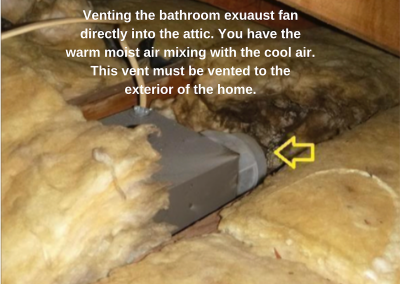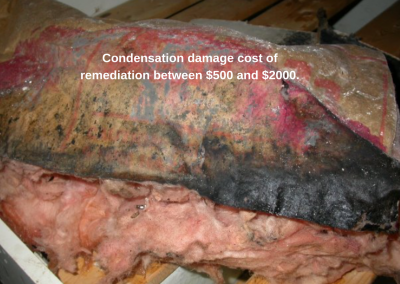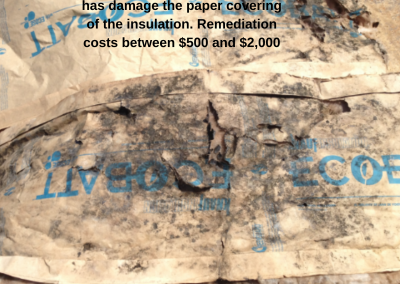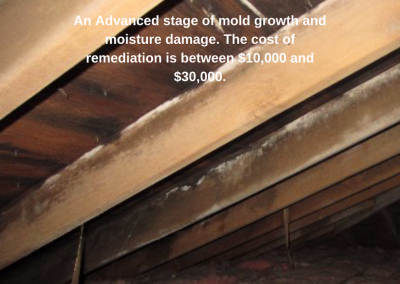Technology Advancements
Introducing The Soffit Vent System By Moisture Flow™
The Soffit Vent by Richard Schofel was accepted by the USPTO on the design, U.S. Patent No.: D918374 under the U.S. Patent Application No.: 29/746,949 Entitled: COMPACT SOFFIT VENT Issued on May 4, 2021.
Moisture Flow® under the direction of Richard Schofel, CEO has licensed Moisture Flow Manufacturing, LLC, for the Marketing, Manufacturing, and Distribution worldwide, known as the “Soffit Vent System” by Moisture Flow®. Respecting the original functionality of the process Moisture Flow® redesigned the configuration of Soffit Vent System. The Soffit Vent is a Compact Vent that is streamlined used for the termination of a bathroom exhaust fan that vents through the soffit and not into the soffit.
Why Is The Soffit Vent System So Important?
The Soffit Vent System solves a long-standing problem in the building industry: the damage caused by venting a bathroom exhaust fan to a soffit. The Soffit Vent System is an adapted termination that now gives builders and homeowners the ability to vent bathroom exhaust fans through the soffit without running the risk of the exhausted air from going back into the attic. It safely and effectively allows venting a bathroom exhaust fan to a soffit. It is a revolutionary alternative to venting through the roof. Cutting into the roof’s sheathing can, and often does, create roof leaks and catastrophic water damage. Venting through the roof can also void a roof warranty. The Soffit Vent System is code compliant under The International Code Council (ICC) and the International Residential Code (IRC). The Soffit Vent was accepted by the USPTO examiners on the functionality and the design. It is now in the registered stage for the publication.
Consequences of Improper Venting
Tom Silva is notable general contractor best know for the series “This Old House” a PBS show for his expert advice to home enthusiasts across the country. He is also known for his book publications. The video below confirms the effects of improper venting.
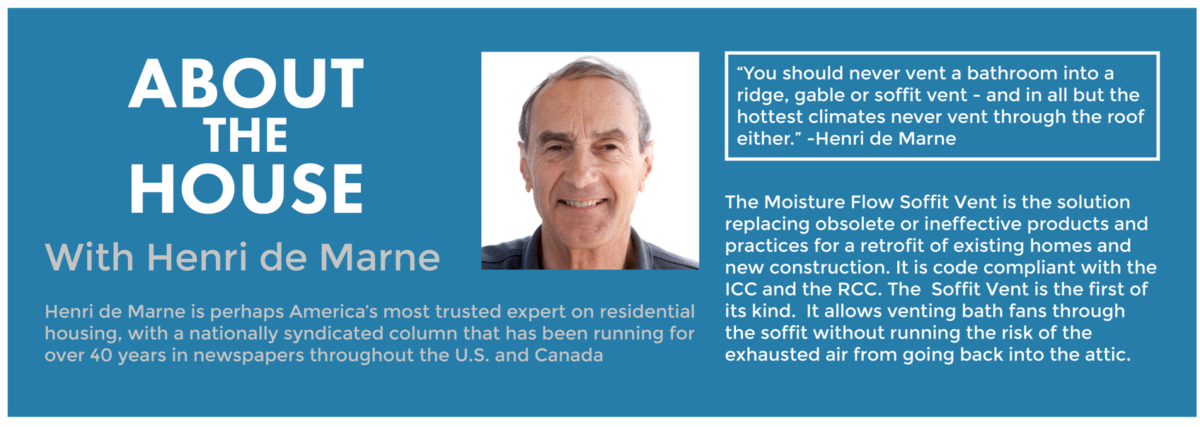
Designed Use:
- A ideal alternative for venting through the roof by home builders and contractors.
- Perfect retrofit for the 295 million existing homes, 5.6 million commercial buildings.
- Fast fast easy and install for the 50 million Do-It-Yourself homeowners in the USA.
How Does The Soffit Vent System Work?
By effectively displaces exhausted air from a bathroom exhaust fan, through a soffit, and out of the soffit’s passive air stream. Effective displacement subscribes to the removal of exhausted air away from the assembly and preventing re-entry.
Our Soffit Vent has multiple points of egress for bulk moisture, should moisture condense inside of the vent. These points of egress also prevent reentry of moisture into the attic and prevent moisture build up inside of the vent. The vent can be used on soffits ranging from 8” to 48” long.
Unique in its function and design, the Soffit Vent System is the only product on the market that takes the exhausting air out of the soffit’s passive air stream. The soffit is designed to take in air, helping to ventilate the roof deck. Subsequently, any air vented within the soffit’s air stream will end up back in the attic. This promotes moisture problems and mold growth. For these reasons – in the residential energy efficiency industry – venting a bath fan into the soffit is considered the least ideal place for venting and is oftentimes utilized as a last resort. This soffit vent termination is truly an industry first. It not only gives builders a real, effective, and viable alternative to venting to the roof or gable wall, it is now the best way to vent a bath fan.
Soffit Vent System Installation
All you need are small hand tools and 20 minutes to install the Soffit Vent System.
Present the Soffit Vent to the ideal position where it will be placed in the soffit. The ideal position is in a straight line from the insulated tube that is attached to the exhaust fan to the soffit area. (1) Present the Soffit Vent System by placing the beveled edge of the nose piece tight up against the interior surface of the fascia. The bottom of the fascia must be positioned so that it falls on the flat surface of the nose piece. Once in the correct position the grill of on the nose piece will extend approximately a 1/4” to 3/8” on the exterior side of the fascia. Note: in some case the bottom edge will fall more than a 1/4” below the soffit as seen in the diagram. It will be necessary to notch out the a section of the fascia so that when the Soffit Vent is in place it is flush against the surface of the soffit. (2) Once the nose piece is in the proper place then measure back to the neck of the vent where it will be placed in the soffit. (3) Mark the diameter of the circular neck. The diameter of the neck of the vent is 3”.09 around the exterior. Mark the center of the diameter then measure a radius of just over 4” to pull the transition duct of the exhaust fan through the hole that was just cut out. The transition duct with the insulated covering is usually 4”. (4) Once the transition duct is has been passed through the soffit place the interior tube on to the neck of the vent. Side the insulated covering down to the base of the vent so that the neck is complete covered. Secure the insulated tube to the neck using a 4”5 jubilee clap and then tighten it to prevent the transition tube from coming off of the vent. (5) Using an exterior chalk place a bead around the perimeter of the neck of vent to cover the excess opening of the diameter of the hole of the insulated tube. (6) Push the excess transition tube back into the soffit area and place the vent against the soffit. The bead of caulk should completely seal the opening in the soffit to prevent insects of entering. (7). Using the proper screws depending on the material of your soffit screw the soffit into place. There are four holes in housing and two holes on the nose piece of the vent.
Common Causes of Attic Mold and Moisture
(1) The bathroom exhaust fan or the fan’s vents directly into the attic.
(2) The bathroom exhaust fan vents directly into the soffit.
(3) Deterioration of a roof vent or the sealants used for the vent.
The Soffit Vent System eliminates all of these risk factors!
Warranty: The Soffit Vent System has an unconditional lifetime warranty.

